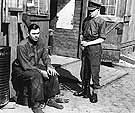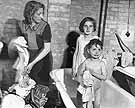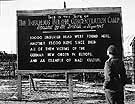
|
|
|

|

|

|

|
|
Click on an image to see a larger, more detailed picture.
|
|
|
|
|
| 1945: Liberation and Rebuilding |

|
pg. 600 |

|
|
|
|
| |
 Josef Kramer, glum and in shackles, was the commandant of Bergen-Belsen at the end of the war. In 1944 he had served as chief of Auschwitz II, the death camp, during the annihilation of Hungary's Jews. He admitted that he had personally gassed prisoners while serving as the commandant of the Natzweiler, Germany, camp. On November 17, 1945, he was sentenced to death for his crimes.
Josef Kramer, glum and in shackles, was the commandant of Bergen-Belsen at the end of the war. In 1944 he had served as chief of Auschwitz II, the death camp, during the annihilation of Hungary's Jews. He admitted that he had personally gassed prisoners while serving as the commandant of the Natzweiler, Germany, camp. On November 17, 1945, he was sentenced to death for his crimes.
Photo: UPI/Corbis-Bettmann
|
 Inmates in the camps were forced to live under incredibly filthy conditions that often led to disease and infestation by parasites. These children at Bergen-Belsen take their first baths in months.
Inmates in the camps were forced to live under incredibly filthy conditions that often led to disease and infestation by parasites. These children at Bergen-Belsen take their first baths in months.
Photo: Imperial War Museum/United States Holocaust Memorial Museum Photo Archive
|
 Bergen-Belsen
Bergen-Belsen
The notorious Bergen-Belsen concentration camp, near Celle in northern Germany, began operations early in 1943. It was designed to house approximately 10,000 Jewish prisoners. The collapse of the German war effort and the consequent closure of camps throughout Eastern Europe forced tens of thousands of inmates to Bergen-Belsen. When the camp was liberated on April 15, 1945, by the British Army, more than 60,000 emaciated and diseased human beings occupied the grounds. The vile living conditions at Bergen-Belsen were similar to those at the camps of Eastern Europe: Food, shelter, and sanitary facilities were entirely inadequate. The declining health of the inmates resulted in thousands being murdered by lethal injections during the summer of 1944. As Bergen-Belsen's camp population swelled in 1945, the situation deteriorated rapidly. Camp officials and the facilities were simply overwhelmed. All efforts to organize and feed the prisoners broke down completely. When British soldiers arrived in April, they were greeted by an unimaginably grisly scene. Corpses were rotting on the ground. Barracks built to house 100 prisoners were stuffed with more than 1000 typhus-ridden, excrement-covered people. Death by disease and starvation claimed 14,000 lives between April 15 and June 20, 1945.
Photo: Archive Photos
|
|

|

|

|

|
 April 1, 1945: The SS initiates death marches to evacuate the concentration camps at Dora-Mittelbau and Kochendorf, Germany.
April 1, 1945: The SS initiates death marches to evacuate the concentration camps at Dora-Mittelbau and Kochendorf, Germany.
|
 April 3, 1945: All 497 members of a slave-labor group at Bratislava, Slovakia, are shot and killed by their captors.
April 3, 1945: All 497 members of a slave-labor group at Bratislava, Slovakia, are shot and killed by their captors.
|
 April 3, 1945: The Nazis evacuate the concentration/slave-labor camp at Nordhausen, Germany; See April 11, 1945.
April 3, 1945: The Nazis evacuate the concentration/slave-labor camp at Nordhausen, Germany; See April 11, 1945.
|
 April 4, 1945: The U.S. 4th Armored Division liberates the concentration camp at Ohrdruf, Germany, the site of more than 4000 deaths during the previous three months. Victims were Jews, Poles, and Soviet POWs. Hundreds shot just before liberation had been working to build an enormous underground radio and telephone communications center. Very few inmates remain alive at liberation.
April 4, 1945: The U.S. 4th Armored Division liberates the concentration camp at Ohrdruf, Germany, the site of more than 4000 deaths during the previous three months. Victims were Jews, Poles, and Soviet POWs. Hundreds shot just before liberation had been working to build an enormous underground radio and telephone communications center. Very few inmates remain alive at liberation.
|
|
|
|
|
| 1945: Liberation and Rebuilding |

|
pg. 600 |

|
|
The Holocaust Chronicle
© 2009 Publications International, Ltd.
|
|
